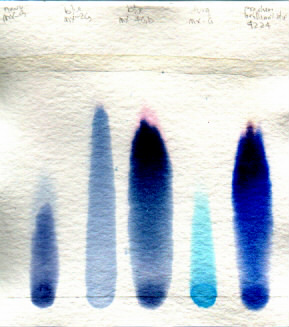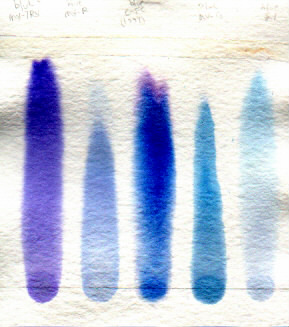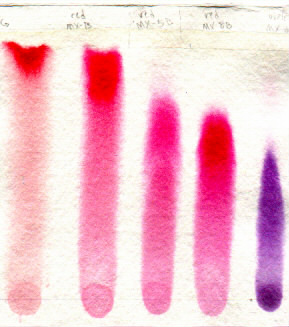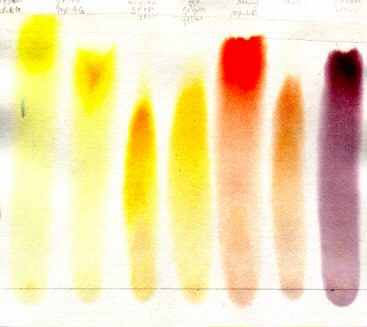
Materials. Good quality blotter paper, tap water, pure dyes.
Methods. For each dye, a few grains of dye were mixed into one drop of cool tap water with a small weighing spatula, then used a dropper to place this on a penciled line drawn 2" from the bottom of a piece of good blotter paper. The paper was folded over one inch from the top. After drying, each page was hung in a box, across strings that had been stretched around the box, with at least 0.5 inch of paper sub merged, the dye spots well clear of the water. The water was allowed to creep up for one hour, until near the top of the paper, at which time the paper was removed and allowed to dry. The water continued to advance upwards on the page, so there are two drying lines marked at the top of the page in pencil. The paper were finally dried in an oven to stop the dye movement. A noteworthy detail is that the water temperature was hot - 130 Fahrenheit - which would tend to decrease the substantivity (affinity for cellulose) of the unreacted dye. Neither wetting agent nor fixative were added.
Results. The following images were scanned at 50 dpi.
The dyes in the chromatogram below are, left to right, navy MX-G (blue #9), blue MX-2G (slate or
cobalt blue),
blue MX-4GD, turquoise MX-G,
and ProChem mixture Brilliant Blue #4224. It seems odd that
the turquoise migrated such a short distance, when it seems
to migrate very well on fabric [presumably due to its low
reaction rate].
Note the distinct reddish halo above the blues for both MX-4RD.
third from the left, and the ProChem Brilliant Blue mixture on the right. If blue MX-4RD is a mixture,
what other blue is it made from? [conclusion: reddish stuff
is not a dye]

The dyes in the chromatogram below are, left to right, blue MX-7RX (blueviolet), blue MX-R (sky blue), blue F-GF (Cibacron F),
blue MX-G (cerulean blue), and blue MX-3G (Aljo's turquoise number two). Note that the only blue that matches the migration
seen in the ProChem mixture 4224 is blue MX-R. Since the concentrations of dyes were not standardized
in this experiment, it is difficult to compare color
intensity. There is no missing the bright reddish halo above
the Cibacron F dye.
It must not be 100% pure.[later conclusion: reddish stuff
is not a dye; the dye is pure]

The dyes below are, left to right, red MX-G, red MX-B, red MX-5B, red MX-8B, and violet MX-2R.
It is quite surprising to see the fuchsia migrate farther than the violet, when the opposite
is routinely observed when dyeing mixtures. [presumably this
is because fuchsia reacts so quickly that its high rate of
diffusion has no chance to show up.]
The faint reddish hint above the violet might be due to a
contaminating splatter of red MX-5B. [no probably the same
reddish non-dye seen in the blues.]

The dyes below are, left to right, yellow MX-8G, yellow MX-4G, yellow MX-GR, yellow MX-3RA, orange MX-2R,
brown MX-GRN, and brown MX-5BR. Yellow MX-8G is the only dye in this series to migrate 100% as far as the water carrying it.
